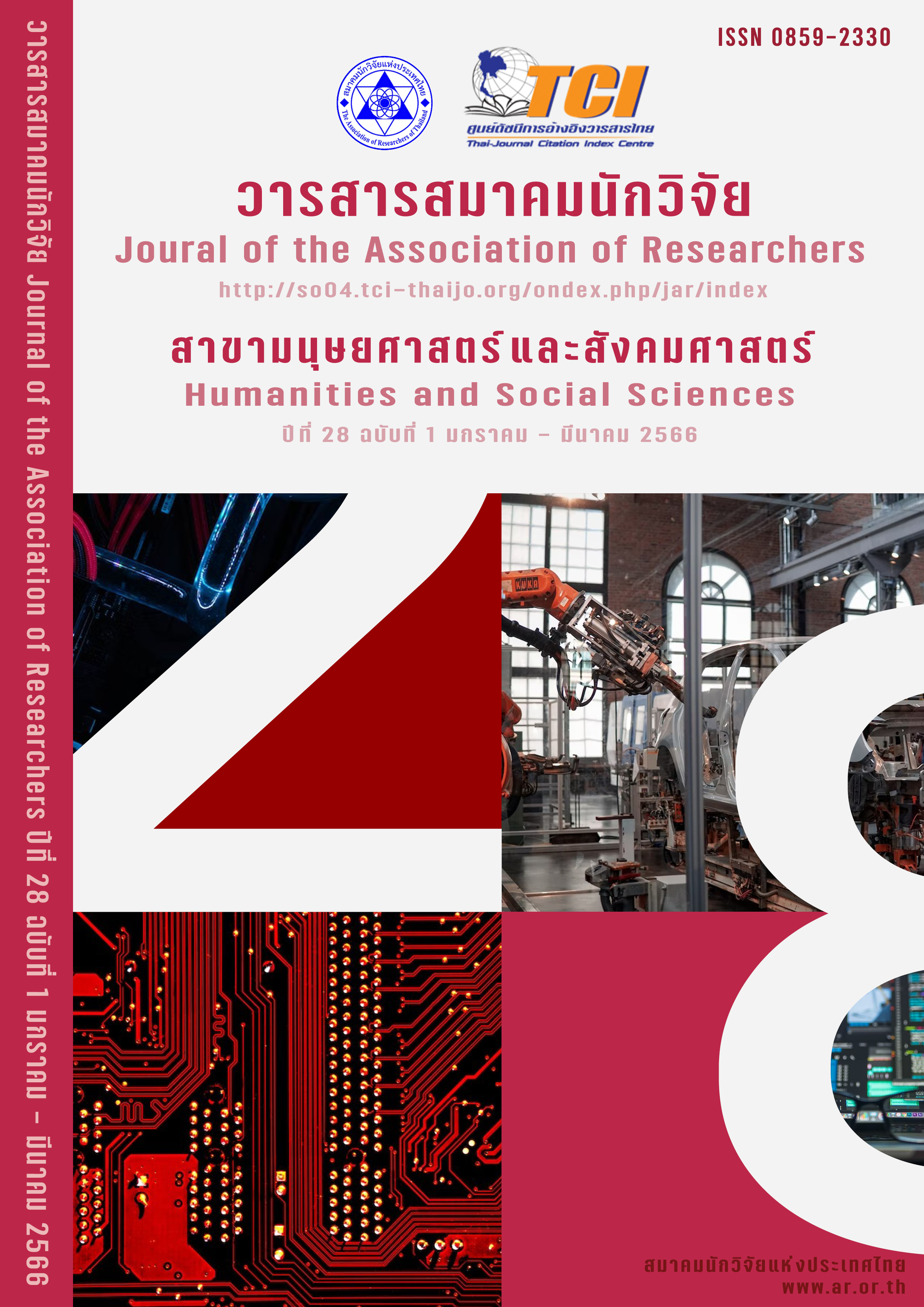A study of the relationship between teachers’ teaching style and students’ classroom participation: A case study of a middle school in China
Main Article Content
Abstract
This research article to were objective 1)To investigate teaching styles of middle school art teachers in a middle school in China 2)To describe student participation in art classrooms in one middle school in China 3)To determine the relationship between the teaching style of middle school art teachers and students' participation. The data were collected through questionnaires; distributed in 145 students in art classrooms. In order to investigate the relationship between these two variables, correlation and regression analysis were applied. The results revealed that there was a significant relationship between teaching style and student participation. However, according to regression analysis, (1) council or activity style and (2) principal or group style have a significant impact on emotional participation. Authority or presentation style, demonstration or coaching style, counselor or activity mode style, principal or group style and the hybrid or blended style had no significant effect on behavioral participation and cognitive participation. Through the research hypothesis, the influence of middle school art teachers' teaching styles on students' classroom participation was constructed based on an analytical framework that used a case study of a typical teaching style in the art classroom of the Middle School. The analysis found that there were significant differences in students' cognitive, behavioral, and affective engagement based on the feedback from the questionnaire data with 145 students participating at a Middle School in China with the same test data variables, which further supports the research hypothesis presented in the introduction section.
Article Details

This work is licensed under a Creative Commons Attribution-NonCommercial-NoDerivatives 4.0 International License.
บทความที่ปรากฏในวารสารนี้ เป็นความรับผิดชอบของผู้เขียน ซึ่งสมาคมนักวิจัยไม่จำเป็นต้องเห็นด้วยเสมอไป การนำเสนอผลงานวิจัยและบทความในวารสารนี้ไปเผยแพร่สามารถกระทำได้ โดยระบุแหล่งอ้างอิงจาก "วารสารสมาคมนักวิจัย"
References
Aypay, A. (2011). The Adaptation of the Teaching-Learning Conceptions Questionnaire and Its Relationships with Epistemological Beliefs. Educational Sciences: Theory and Practice, 11(1), 21-29.
Bell, R. R. , Solomon, D. , Bezdek, W. E. , & Rosenberg, L. . (1964). Teaching styles and learning. American Sociological Review, 29(4), 627.
Ben-Eliyahu, A., Moore, D., Dorph, R., & Schunn, C. D. (2018). Investigating the multidimensionality of engagement: Affective, behavioral, and cognitive engagement across science activities and contexts. Contemporary Educational Psychology, 53, 87-105.
Bohren, A. (2019). Teaching Styles: Everything you need to know about teaching methods and strategies. Retrieved on 06 August 2020 from,https://blog.cognifit.com/teaching-styles.
Chalkley, T. W. , & Nicholas, D. . (1997). Teachers' use of information technology: observations of primary school classroom practice. Aslib Proceedings, 49(4), 97-107.
Crosthwaite, R.P, Bailay, D.R. & Meeke, A. 2015). Assessing in-class participation for EFL: considerations of effectiveness and fairness for different learning styles. Language Testing in Asia (2015) 5 (9), 1-19. :9 DOI 10.1186/s40468-015-0017-1.
Dallimore, EJ, Hertenstein, JH, & Platt, MB. (2010). Class participation in accounting courses: Factors that affect student comfort and learning. Accounting Education, 25(4), 613–629.
Dunn, R. S., & Dunn, K.J. (1979). Learning styles/teaching styles: Should they... can they... be matched? Educational Leadership, 36(4), 238- 244.
Grasha, A. F. (1994). A matter of style: The teacher as expert, formal authority, personal model, facilitator, and delegator. College Teaching, 42(4), 142-149. 16.
Grasha, A. F. (2002). Teaching with style: A practical guide to enhancing learning by understanding teaching and learning styles. Alliance Publishers.CA.
Grasha, A. F. (1996). Teaching with style: A practical guide to enhance learning by understanding learning and teaching style. College Teaching, 48, 1-12.
Grasha, A. F & Hicks, N. Y. (2000). Integrating teaching styles and learning style with instructional technology. College Teaching, 48(1), 2-15.
Kark, S. A. , & Higgins, J. K. . (2009). Integrated method of teaching cooking and reinforcing cooking skills. U.S. Patent Application No. 11/828,184, US20090029326 A1.
Lei, H., Cui, Y. & Zhou, W.( 2018). Relationships between student engagement and academic achievement: A Meta-Analysis. Social Behavior and Personality. 46(3), 517-528. https://doi.org/10.2224/sbp.7054.
Lorenzo, A.R., & Lorenzo, B.U. (2013). Learning styles of teacher education students: Basis in improving the teaching-learning process, Procedia-Social and Behavioral Sciences, 10(3), 595-605.
Morozov, A., Herrenkohl, L. R., Shutt, K., Thummaphan, P., Vye, N., Abbott, R. D., & Scalone, G. (2014). Emotional engagement in agentive science learning environments. Boulder, CO: International Society of the Learning Sciences.
Perry, C. (1994). Students’ learning styles: Implications for teacher education. The 24th Annual Meeting of the Australian Teacher Education Association, Brisbane, Australia.
Rasmussen, C. L. (1996). Qualitative problem solving strategies of first order differential equations: the case of Amy. In Electronic Proceedings of the Fifth Conference on the Teaching of Mathematics.
Shaari, A. S., Yusoff, N. M., Ghazali, I. M., Osman, R. H., & Dzahir, N. F. M. (2014). The relationship between lecturers’ teaching style and students’ academic engagement. Procedia-Social and Behavioral Sciences, 118, 10-20.
Stephan, R. M. (2007). Legal Framework of Groundwater Management in the Middle East (Israel, Jordan, Lebanon, Syria and the Palestinian Territories). In Water resources in the Middle East (pp. 293-299). Springer, Berlin, Heidelberg.
Sun,M.Y., & Wang,C.H.(2007).The relationship between teacher discipline and students’learning motivation in school. Journal of Primary and Secondary Education Research,18, 165-193.
Toh, R. Q. E., et al. (2022). The role of mentoring, supervision, coaching, teaching and instruction on professional identity formation: a systematic scoping review. BMC Medical Education.
UNESCO (2014). Teaching and learning: achieving quality for all; EFA global monitoring report, 2013-2014. available on https://unesdoc.unesco.org/ark:/48223/pf0000225660
Vaughn, L. , & Baker, R. . (2001). Teaching in the medical setting: balancing teaching styles, learning styles and teaching methods. Medical Teacher, 23(6), 610-612.
Walla, L. A. (1988). Relationship of Teaching Styles and Learning Styles to Classroom Environment . Theses, Dissertations, & Student Scholarship: Agricultural Leadership, Education & Communication Department. Retrieved from https://digitalcommons.unl.edu/aglecdiss/70
Weaver, RR, & Qi, J. (2005). Classroom organisation and participation: College students’ perceptions. Journal of Higher Education, 76(5), 570–601.
Wang, M. T., Degol, J. L., & Henry, D. A. (2019). An integrative development-in-sociocultural-context model for children’s engagement in learning. American Psychologist, 74(9), 1086-1102. https://doi.org/10.1037/amp0000522


